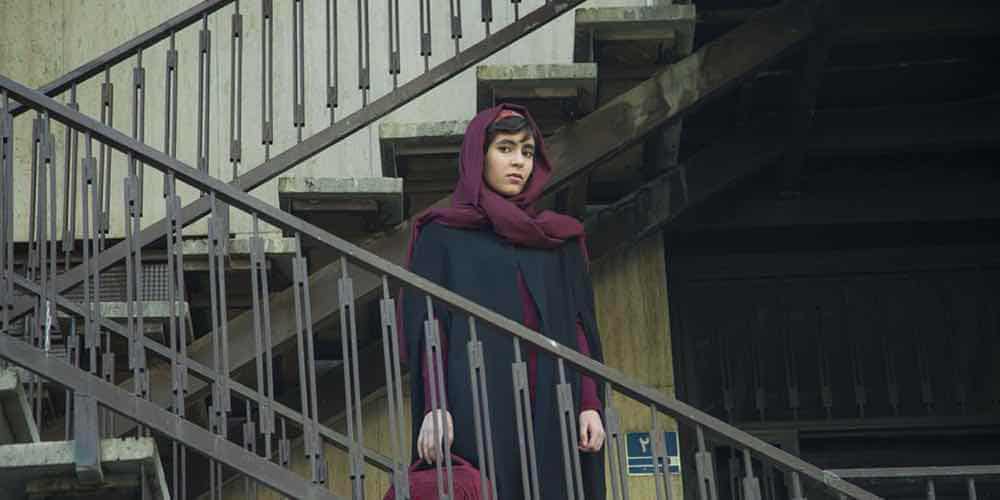Iranian-Canadian filmmaker Sadaf Foroughi discusses her Discovery Peogramme FIPRESCI winner Ava and making a feminist film.

Winner of the FIPRESCI award for the Discovery programme, Sadaf Foroughi’s Ava follows the slow unravelling of a teenage girl’s life in Iran. Under the constant berating of her stepmother and the strict control of a ruthless school principal, Ava suffers cruel and extreme consequences for the harmless childish games she plays with her friends, in an upper-class world where her reputation is everything. Foroughi’s impressive feature debut handles this difficult situation with inspiring subtlety and a self-assured, unique visual style. Although the film looks upon Ava with infinite compassion, she is never infantilized: lead actress Mahour Jabbari plays her character with a force and conviction that makes this young, first-time actress one of the revelations of the festival.
I talked with director Sadaf Foroughi at TIFF about visual storytelling, making a feminist film, and avoiding cliche.
Seventh Row (7R): How did you get the idea for this film?
Sadaf Foroughi: It came directly from my personal life. The story is very close to what I went through during my adolescence. So I started with this experience, then dramatised it into a script.
7R: Today, is there still that pressure on Iranian women to maintain their reputation, even at the expense of their well-being and happiness?
Sadaf Foroughi: Totally. Maybe traditions are a little more important and thus a little more oppressive in small cities: people there all know each other. It’s easier to enforce those traditions. Tehran, on the other hand, is really big, so women can avoid this pressure to an extent, and they can work there, etc.
7R: Despite these extremely conservative rules, all the girls in the school are completely modern — in their attitude, in the things they wear, in the things they talk about. They only follow the school’s rules because they don’t want to get into trouble, not because they agree with them.
Sadaf Foroughi: I really like what you said about how we don’t like the rules, but we have to follow them. It’s so true. They know perfectly what the world without rules is like — from the internet, from cable television. And they travel a lot. So they are aware of how other adolescents live. That’s why they have sneakers, backpacks… But at the same time, I didn’t want to reduce the characters to their social function. I didn’t want to make a film just about those rules. It is, first of all, a story about human beings, about love, dreams, hope. It’s a universal story about a young girl trying to get free.
[clickToTweet tweet=”‘I didn’t want to have this handheld camera style that is so often used for social realist dramas.'” quote=”‘I didn’t want to have this handheld camera style that is so often used for social realist dramas.'”]
7R: How did you develop the film’s visual style? You use a lot of shallow focus where elements become clearer when they move towards the camera, and blurry when they move away.
Sadaf Foroughi: My film is social realist. It is very much about real life and very traditional storytelling, with a clear structure. But I didn’t want a classic approach to this story. I didn’t want to have this handheld camera style that is so often used for social realist dramas. I wanted this sense of alienation, this distance between two sides, and the shallow focus really allowed for that. Because when we get farther from this everyday reality of the characters, we start to go deeper, and to find the verité — deeper in the characters, deeper in the images.
[clickToTweet tweet=”‘I wanted this sense of alienation, and the shallow focus really allowed for that.'” quote=”‘I wanted this sense of alienation, and the shallow focus really allowed for that.'”]
I was influenced by impressionist painters, Degas especially. The colour palette in the film come from Degas. These bright colours are also very adolescent. Their brightness echoes the energy of youth.
But I also had to conform to the limitations in portraying women in Iranian cinema. All the women are isolated in their homes. Even the mirror shows this pressure, this movement between past and present, from the story of the mother to the story of the daughter. I had to think about all these things before the shoot, to have everything planned, because I shot the film in 18 days.
[clickToTweet tweet=”‘The colour palette in the film come from Degas. These bright colours echo the energy of youth.'” quote=”‘The colour palette in the film come from Degas. These bright colours echo the energy of youth.'”]

7R: How did you work with lead actress Mahour Jabbari to prepare her for the role?
Sadaf Foroughi: We rehearsed for two months. She wasn’t an actress when she started working with me, but I think she’s very talented. We analysed the script together as if it wasn’t me who had written it. She would ask me questions about it, and I would have to really think about it from this new perspective, which was really productive.
We worked for a month, about three hours per day. I added the other characters — the mother, the father — only once Ava’s character was absolutely ready, because the film is Ava’s story. All the other characters are played by actors. She’s the only one who is a non-actor.
7R: The movie is feminist, because it is definitely aligned with Ava and very clearly questioning and condemning those rules and traditions.
Sadaf Foroughi: The film is feminist in where its sympathies lie, but I also tried to find a feminist way to tell this story, a feminist aesthetic — with very intimate places, intertwined corridors, moments of touching and connection.
[clickToTweet tweet=”‘The film is feminist in where its sympathies lie, but I also tried to find a feminist aesthetic.'” quote=”‘The film is feminist in where its sympathies lie, but I also tried to find a feminist aesthetic.'”]
I wanted to tell the story of a family. If you want to change anything, you have to change it at home. So it’s more a critique of the mothers, who give birth and nurture the next generation, and who should give their children freedom and happiness.
[clickToTweet tweet=”‘I wanted to tell the story of a family. If you want to change anything, you have to change it at home.'” quote=”‘I wanted to tell the story of a family. If you want to change anything, you have to change it at home.'”]
7R: Ava’s father is really passive and powerless, despite living in a world where men are relatively free and women are under much more pressure. His wife decides everything, and he lets her do it.
Sadaf Foroughi: I didn’t want to follow the cliché of Iranian men being hard and mean and Iranian women being very gentle and submissive. It’s not true. As I said, this is based on my personal life. It’s not a copy, but I did live in a family where my mother had all this power, and my father was cool and relaxed.
Same for the school principal. Even though, from a quick glance, she just looks like a bad person, I made her more colourful, like a sort of caricature. She wears those white gloves. She has this strange habit of putting her fancy sugar bowl into a plastic bag. She’s a control freak. She also has a really sweet face, which makes her even scarier and more unreal.
7R: What’s your next project?
Sadaf Foroughi: I’m working on my next feature, which is again a coming of age drama. It tells a story of forbidden love between two boys in Iran.
Read all of our TIFF17 coverage here >>

